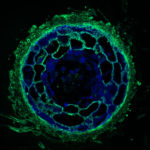Kaushal Sharma, one of five Antioch High School rising juniors who participated in internships at the DOE Joint Genome Institute (JGI) this summer through the Biotech Partners program is now an author on a Nucleic Acids Research publication. The paper describes the version 6 data updates and feature enhancements to the Genomes OnLine Database (GOLD) administered by JGI. T.B.K Reddy, Kaushal’s mentor, described his student’s contributions as reviewing close to 3,800 metagenomes to verify geographic locations and assign latitude and longitude values “This exercise helped us in filling or updating geographic information for nearly 1,100 samples,” said Reddy. Kaushal also reviewed and assigned NCBI taxonomy name and IDs for nearly 20,000 public/private mtagenome biosamples in GOLD. “Besides these, he curated several small sets of phylogeny, biosample metadata tasks we assigned.” What did you do for your summer vacation?
New Bacteria Groups, and Stunning Diversity, Discovered Underground
Lawrence Berkeley National Laboratory (Berkeley Lab) and UC Berkeley researchers have uncovered new clues about the roles of subsurface microbes in globally important cycles. Jill Banfield, senior faculty scientist in the Earth & Environmental Systems Area and professor at UC Berkeley, led the research team that studied soil and water samples containing subsurface microbes collected at a Colorado River basin field site. DNA sequencing of these microbes was performed at the Joint Genome Institute (JGI), a DOE Office of Science User Facility.
As reported online October 24 in the journal Nature Communications, the scientists netted genomes from 80 percent of all known bacterial phyla, a remarkable degree of biological diversity at one location. They also discovered 47 new phylum level bacterial groups, naming many of them after influential microbiologists and other scientists, including ten in the Biosciences Area (with the form Candidatus Surnamebacteria). Phyla-level names have been proposed for Molecular Biophysics & Integrated Bioimaging Division’s Cheryl Kerfeld, Krishna Niyogi, and Jennifer Doudna; Environmental Genomics & Systems Biology’s Louise Glass, Kathleen Ryan, Steven Brenner, Mary Wildermuth, and Judy Wall; and the JGI’s John Vogel and Tanja Woyke. The researchers analyzed the metabolic interactions of these and other subsurface microbes to better understand their roles in ecosystem resilience. Read the full story at the Berkeley Lab News Center.
Biosciences Staff Honored with Director’s Awards
Several Biosciences Area personnel have been named as recipients of 2016 Berkeley Lab Director’s Awards. Yan Liang (Biological Systems & Engineering), Eva Nogales, and William Jagust (Molecular Biophysics & Integrated Bioimaging, MBIB) were honored with individual awards in Early Career, Scientific Achievement, and Societal Impact, respectively. Jill Fuss and Steven Yannone (MBIB) were the recipients of a team award in Technology Transfer for the launch of their company CinderBio. Jim Bristow (Biosciences Area Office, Trent Northen (Environmental Genomics & Systems Biology & Joint Genome Institute, JGI), and Susannah Tringe (JGI), along with Eoin Brodie and Peter Nico of the Earth and Environmental Sciences Area, were named in a team award in Service.
Modeling Microbial Networks in an Oxygen Minimum Zone
With help from two DOE national user facilities – JGI and the Environmental Molecular Sciences – a team at the University of British Columbia has developed a math model that could help researchers and policy makers track the impact of climate change on the microbial networks that drive the world’s marine ecosystems. The model couples omic information and biogeochemical data from the Saanich Inlet ecosystem in British Columbia, Canada, which has long been used as an analog for studying oxygen minimum zones. Read more about the impact of this work, recently published in the Proceedings of the National Academy of Sciences, here.
How Fungi Help Trees Tolerate Drought
The mutualistic relationship between tree roots and ectomycorrhizal (ECM) fungi has been shaping forest ecosystems since their inception. ECM fungi are key players supporting the growth, health and stress tolerance of forest trees globally, and help boost the productivity of bioenergy feedstock trees. To learn more about what characteristics are dominant in the most common ECM fungus Cenococcum geophilum, a team including researchers at the DOE Joint Genome Institute (JGI) compared its genome with the genomes of two close relatives, neither of which are ECM fungi. They found specific adaptations in the Cenococcum genome that could help their hosts be more resistant to drought stress, a finding that could be useful in developing more plant feedstocks for bioenergy amidst the changing climate. The study was published date September 2 in Nature Communications. Read more at JGI News.
- « Previous Page
- 1
- …
- 40
- 41
- 42
- 43
- 44
- …
- 46
- Next Page »
Was this page useful?








